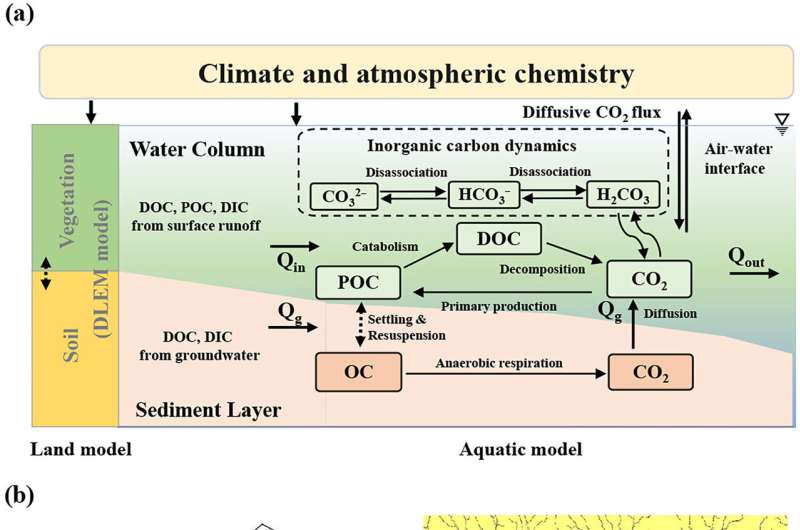This article has been reviewed according to Science X's editorial process and policies. Editors have highlighted the following attributes while ensuring the content's credibility:
fact-checked
peer-reviewed publication
proofread
Gently down the stream: Carbon's journey from land to sea and beyond

Rivers, streams, lakes, and reservoirs occupy just 1% of Earth's surface, but they provide a route for large amounts of terrestrial carbon to reach the ocean. Along the journey, carbon dioxide is also released into the atmosphere in a process known as evasion. But much about the land-to-ocean carbon cycle is not yet understood.
Knowing how much carbon is transported from land to ocean and how much is lost to the atmosphere and elsewhere on the journey—and how factors like human activity and ecosystem type influence these processes—could help scientists gain a more complete picture of the global carbon cycle.
A study published in Global Biogeochemical Cycles presents a global quantification of carbon export and carbon dioxide (CO2) evasion from before the industrial era to the present. The research indicates that inland waters move nearly half of the carbon absorbed by the land to the atmosphere and oceans.
It also reveals significant anthropogenic perturbations to this land-to-ocean carbon cycle. Their work is the first global quantitative assessment of this process, addressing a knowledge gap identified in the Intergovernmental Panel on Climate Change's Sixth Assessment Report.
Using the Terrestrial/Aquatic Continuum module of the Dynamic Land Ecosystem Model, the researchers conducted simulations moving from a preindustrial baseline forward in time. This allowed them to observe the effects of different variables on the land-to-ocean carbon cycle, including increased atmospheric carbon, land use change, and increasing nitrogen inputs to rivers.
Their model shows a 25% increase in global carbon entering the water from 1800 to 2019. Of that extra carbon, 23% was exported to the oceans by rivers, whereas 59% was evaded to the atmosphere. In total, inland waters today transport 869 teragrams of carbon to the ocean and 1,113 teragrams of carbon to the atmosphere per year.
Some notable knowledge gaps remain, including the extent to which anthropogenic influences are affecting the transport of carbon from land to ocean. In addition, there is a need for better observations in headwater zones and arctic regions.
More information: Hanqin Tian et al, Increased Terrestrial Carbon Export and CO2 Evasion From Global Inland Waters Since the Preindustrial Era, Global Biogeochemical Cycles (2023). DOI: 10.1029/2023GB007776
Journal information: Global Biogeochemical Cycles
Provided by Eos
This story is republished courtesy of Eos, hosted by the American Geophysical Union. Read the original story here.



















